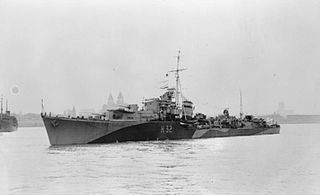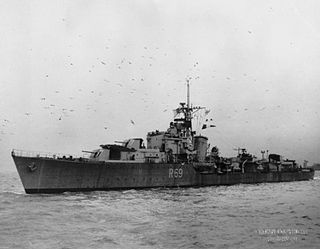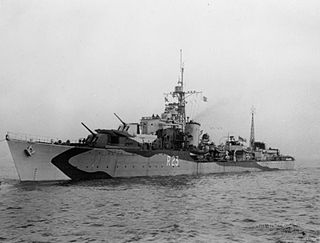
HMS Loch Dunvegan was a Loch-class frigate of the British Royal Navy, named after Loch Dunvegan in Scotland. Launched in 1944, the ship saw service in the Second World War, and in the Mediterranean Fleet in the early 1950s, before being broken up in 1960.

HMS Tuscan was a T-class destroyer of the British Royal Navy that served during the Second World War and was scrapped in 1966.

HMS Rapid was an R-class destroyer of the Royal Navy that saw service during the Second World War and was sunk as a target in 1981.

HMS Roebuck was an R-class destroyer of the British Royal Navy that saw service during World War II. She was the fifteenth ship to carry this traditional ship name, after a small deer native to the British Isles, which was used as far back as the reign of Queen Elizabeth I.

HMS Rocket was an R-class destroyer of the Royal Navy that saw service during Second World War. Built by Scotts Shipbuilding and Engineering Company in Greenock, Scotland, she was launched in October 1942 and commissioned in August 1943.

HMS Relentless was an R-class destroyer of the Royal Navy that saw service during World War II. She was later converted into a Type 15 fast anti-submarine frigate, with the new pennant number F185.

HMS Ulysses was a U-class destroyer of the British Royal Navy that saw service during World War II. She was later converted into a Type 15 fast anti-submarine frigate, with the new pennant number F17.

HMS Undine was a U-class destroyer of the British Royal Navy that saw service during World War II. On 27 March 1945, HMS Undine detached from RN Fast Carrier TF57 to rescue the airmen of a downed RN TBF Avenger aircraft also rescued a USN Corsair pilot adrift for two days south of the Sakishima Gunto in the Philippine Sea.

HMS Urania was a U-class destroyer of the British Royal Navy that saw service during World War II. After the war she was converted into a Type 15 fast anti-submarine frigate and was scrapped in 1971.

HMS Venus was a V-class destroyer of the Royal Navy that saw service during the Second World War. She was built by Fairfield Shipbuilding and Engineering Company, of Govan, Scotland and launched on 23 February 1943.

HMS Virago was a V-class destroyer of the British Royal Navy that served in World War II. She was later converted into a Type 15 fast anti-submarine frigate, with the new pennant number F76.

HMS Wrangler was one of eight W-class destroyers built for the Royal Navy during World War II. Completed in 1944, the ship spent most of the war in the Far East and escorted British aircraft carriers as their aircraft attacked targets in the occupied Dutch East Indies and in Japan itself. Wrangler was present in Tokyo Bay when the Japanese formally surrendered on 2 September 1945.

HMS Teazer was a T-class destroyer of the Royal Navy that saw service during the Second World War. She was later converted to a Type 16 fast anti-submarine frigate, with the new pennant number F23.

HMS Termagant was a T-class destroyer of the Royal Navy that saw service during the Second World War. She was built by William Denny and Brothers, of Dumbarton and launched on 22 March 1943. She was scrapped in 1965.

HMS Carysfort was a C-class destroyer of the Royal Navy. She was ordered in 1941, originally under the name HMS Pique.

HMS Obdurate was an O-class destroyer of the Royal Navy. She was built by William Denny and Brothers of Dumbarton, being laid down at their yards on the River Clyde on 25 April 1940, launched on 19 February 1942 and commissioned on 3 September 1942.

HMS Crispin was a C-class destroyer of the Royal Navy built by J. Samuel White, Cowes between 1944 and 1946. She was originally to have been named HMS Craccher. She was sold to the Pakistan Navy in 1958 and renamed PNS Jahangir. She was scrapped in 1982.

HMS Obedient was an O-class destroyer of the Royal Navy. She was built by William Denny and Brothers of Dumbarton, between 1940 and 1942. During Warship Week in 1942 she was adopted by the civil community of Lymington, United Kingdom. She was scrapped in 1962.

HMS Brocklesby was a Type I Hunt-class destroyer of the Royal Navy. She served during the Second World War, spending much of the time in the English Channel and Mediterranean, taking part in the Dieppe Raid in 1942, and the Allied landings in Sicily and at Salerno in 1943. After the war, she was used as a sonar trials ship until 1963, and was sold for scrap in 1968.

HMS Wilton was a Type 2 Hunt-class destroyer of the Royal Navy that served in the Second World War.





















